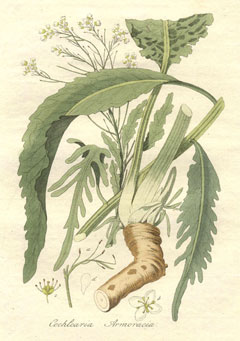
Horseradish, Red Cole
Latin Name: Armoracia rusticana
USDA Hardiness: 4-9
Native Range: EUROPE: Moldova,
Edibility Rating: 3 / 5
Medicinal Rating: 3 / 5
Region:
Family:
Plant Type:
Medicinal Uses
Edible Uses
Edible Parts: Leaves Root Seed | Edible Uses: CondimentYoung root - raw or cooked. The grated root is used to make the condiment 'Horseradish sauce'[2, 9, 13, 14, 27, 33, 34, 52], this has a hot mustard-like flavour[100]. The sauce is best used uncooked or gently warmed, heating it will destroy the volatile oils that are responsible for its pungency[238]. It is said that in Germany the roots are sliced and cooked like parsnips[183] - rather them than me![K]. The root is a rich source of sulphur[201]. Fresh roots contain the glycoside sinigrin - this is decomposed in the presence of water by the enzyme myrosin, producing mustard oil which gives the root its hot flavour[268]. The fleshy roots can be up to 60cm long and 5cm thick[268]. The plant is fully hardy and can be left in the ground all winter to be harvested as required[4]. Alternatively, the roots can be harvested in early winter and stored for later use, they will retain their juicy state for some time if stored in dry sand[4]. Young leaves - raw or cooked[2, 9, 14, 177]. A very strong flavour, though nice when added in small quantities to the salad bowl[183, K]. A pleasant mild flavour according to another report[238]. Seeds - sprouted and eaten in salads[183].
Cultivation
Landscape Uses:Massing, Seashore. A very easily grown plant, horseradish prefers a good deep moist well-drained soil and a sunny position[16, 27, 33, 200]. Plants require a good soil if they are to produce good roots[4], though once established they are very tolerant of neglect and will continue to produce a crop for many years[264, K]. Plants do not thrive if they are in the shade of trees[264]. Excess nitrogen causes heavy top growth and forking of the roots[200]. Prefers a wet clay soil according to one report[14], whilst another says that it will not grow in wet clay[16]. Tolerates a pH in the range 5.8 to 8.3. Horseradish has long been cultivated for its root which is used as a food flavouring and medicinally, there are some named varieties[4, 17, 61, 183]. If the roots are given some protection they will produce fresh young leaves for the salad bowl all through the winter. Digging up some roots and putting them into a greenhouse for the winter is the easiest method. If the young shoots are blanched they will produce white, tender, sweet leaves[183]. A very invasive plant[33], it is considered to be a pernicious weed in some areas[200]. Even quite small sections of root will regrow if they are left in the soil[4]. The plant has yet to prove invasive on our Cornwall trial grounds, though it has survived and even prospered in a very overgrown site[K]. The forms of this plant grown in gardens are almost sterile and seldom produce good seed[264]. This is a good companion plant for potatoes since it is said to deter potato eelworm[14, 18, 201] and the Colorado beetle[238]. One plant at each corner of the potato patch is quite sufficient[201]. When grown under apple trees it is said to prevent brown rot, powdery mildew and other fungal diseases[201].Special Features:Fragrant foliage, Not North American native, Invasive, Naturalizing, Fragrant flowers. The plant is heat tolerant in zones 12 through 1. (Plant Hardiness Zones show how well plants withstand cold winter temperatures. Plant Heat Zones show when plants would start suffering from the heat. The Plant Heat Zone map is based on the number of "heat days" experienced in a given area where the temperature climbs to over 86 degrees F (30°C). At this temperature, many plants begin to suffer physiological damage. Heat Zones range from 1 (no heat days) to 12 (210 or more heat days). For example Heat Zone. 11-1 indicates that the plant is heat tolerant in zones 11 through 1.) For polyculture design as well as the above-ground architecture (form - tree, shrub etc. and size shown above) information on the habit and root pattern is also useful and given here if available. The plant growth habit is a runner spreading indefinitely by rhizomes or stolons [1-2]. The root pattern is a tap root similar to a carrot going directly down [1-2].
Known Hazards
Large quantities of this plant can be poisonous due to its content of volatile oils[76]. Traditional texts suggested possible thyroid function depression. Contraindicated with chronic nephritis, hepatitis, gastro-oesophageal reflux or hyperacidity conditions, and inflammatory bowel conditions. Avoid during pregnancy and lactation (moderate amounts with food ok)[301].
Habitats
Arable land, waste ground and by streams[9], favouring slightly damp positions[165].